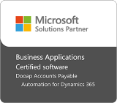Many companies are turning to finance process automation for the visibility and efficiencies that help their current practices run smoother and more effectively. While many are making progress in those areas, it is often not enough and they need to consider advanced automation. Without getting your house in order and removing paper and manual process steps, you can’t get the visibility and efficiencies you need, and that’s where advanced automation comes in.
Advanced automation also plays a key role in analytics, which can help you uncover insights in order to improve processes, guide financial decision-making and identify new ways to save money and work smarter. For example, these insights are not just important for Accounts Payable (AP). As the keeper of key data on spend, payments and outstanding liabilities, AP has information critical to cash flow and sound financial operations, of interest to departments across the organization, such as Finance and Treasury.
So how can you best leverage analytics? First, it’s important to consider the differences between reporting and analytics – which, while they often get confused, are two very different things. While reporting covers gathering key data history, analytics involves handling, presenting and visualizing data in a way that it benefits the business, by understanding and interpreting its content and providing views of the future.
Consider this example:
A CFO described his AP manager as follows: “We have a very dedicated AP Manager who works hard to make sure all our invoices are correctly entered into our ERP system. Yet, if I ask him how our open invoices will affect our cash outflows next month, he’s unable to answer that.”
This conversation sheds light on an old-school way of thinking that needs to change in order to gain the greatest value from automation. Instead of keying in invoice data, matching figures and printing out reports – which is what reporting is all about – more and more AP professionals are expected to understand what the numbers they are crunching mean – in essence, analyze the data. So how could this AP manager – and you – best prepare your data for analytics? The first step involves getting your operations in order, by ensuring you have accurate, high-quality data and efficient processes. While it is absolutely vital to make sure your processes work and the accounts are up to date, it’s not enough. It is when you begin pulling out the data from reports and analyzing it that the most valuable phase begins in a modern finance organization.
You should get to this point as quickly as possible with accurate numbers, and that is where automation comes into play. You need to fully automate your processes and eliminate any paper-based processes, which are not only a time sink, but also impair your real-time visibility into invoices and the valuable data they contain.
Going beyond reporting
If we continue the sequence of events in the above example and imagine that the AP manager would have been able to answer the CFO about cash outflows, would the conversation have ended there? Probably not. The next question might have been: “Okay then, how does the cash burn look for the next three months?” While he could answer that he left his crystal ball at home and couldn’t really tell, that probably isn’t the answer his boss is looking for.
So, what would be the right answer? It’s all based on the analytics. Using an advanced AP automation tool, he could analyze the data based on previous patterns. This is a good starting point and is handled automatically without any manual work. From there, the AP manager can add exceptions into the analysis, and use his insight and experience to ensure that accurate, relevant data is extracted from the system. If he needs further information, he can drill down to the vendor and/or business unit level to see if something pops up that he might not understand.
Knowledge can drive change
It has been said that data and reporting are of no use if they do not lead to a change in operations that benefits the organization. So, always remember to ask “why?” and “how does this data benefit us?” Modern AP solutions provide automated data handling and analysis of trends and exceptions. Our job is to link these to the real world, find the areas that need action, and move ahead with them.
Furthering AP’s role as a valued business partner
So how can we put these ideas into motion? We should find ways to leverage the core value-add of analytics – instead of focusing on what happened in the present, we should look at why things happened and what it means for the future.
Then, finance professionals can move from being just processors of data into professionals capable of using and interpreting it for business benefit.
Some goals to consider for this fall: Let us not lay back when we get a report, but instead try to uncover what it is telling us. Let us find out how our back-office processes link to the business and look at the figures from this perspective. Let us find the trends and exceptions and the root causes. Let us identify the people in our organization who can benefit from our analysis and let’s communicate this information to them effectively, in the way that’s most helpful to them. This is how we can be business partners, running modern finance operations and supporting our finance teams, so they can best move the business forward. That’s what AP is meant for. Who wouldn’t want to be in that role?
Learn more about how to leverage analytics in your AP process.








